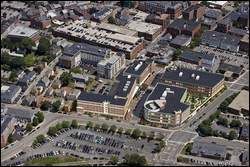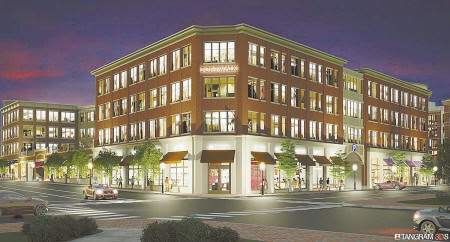Smuttynose
Active Member
- Joined
- May 26, 2006
- Messages
- 686
- Reaction score
- 3,728
HDC to take second look at Portsmouth Bookstore project
PORTSMOUTH ? A proposal to tear down a portion of the former Portsmouth Book Shop building and redevelop the property to a mixed-se commercial and residential development could be headed back to the Historic District Commission for a third review.
Developer Steve Kelm seeks to redevelop the property at 7 Islington St. The Harbour Lights building on Bridge Street and a single family home on Tanner Street would be demolished as part of the project to construct a mix of commercial and residential space.
The Board of Adjustment last week voted 5-2 to send the project back to the commission. HDC approval is required for the project to move forward. Applicants who are denied HDC approval can appeal to the city's Board of Adjustment.
The HDC reviews all designs within the city's historic district to ensure they conform with surrounding architecture.
Paul McEachern, attorney for the developer, said the commission committed a legal error when it evaluated the impact of the proposal on the adjacent Tanner Street neighborhood ? which lies outside the historic district.
The developer's architect Steve McHenry also stated the commission's concerns came up very late in the process. The commission had already held five work sessions on the project before making its concerns known to the applicant.
McEachern's other issues were that Vice Chairman David Adams should have recused himself from the vote during the rehearing, saying Adams had already publicly stated he would not change his mind on the matter. Also, McEachern said the commission failed to act on the application within 45 days of it being submitted and did not adequately state reasons for denying approval.
"In my reading of the record, they just didn't plain follow the statute," he said. "They don't have a choice as to whether or not they're going to follow the statutes."
Some abutters restated their opposition to the proposal. Martin Burns of 280 Hanover St. said the back of the proposed building that faces Bridge Street is unattractive. "What you're going to see is a large brick wall," he said. Commission members also testified. Adams pointed out that the city's ordinance says the commission has to be concerned about the "special character" of an area around a project and does not state specifically that it has to lie in the historic district.
HDC Chairman John Rice spoke about how the commission had an "epiphany" about how big the building was going to be when it did a site walk on Tanner Street. "You have a gentle little neighborhood that we hadn't seen until the night of the site walk," he said.
Although the Board of Adjustment could have upheld the commission's decision or overturned it, it decided to send it back for another review. Board member Arthur Parrott said he believes both parties raised significant issues as to whether Tanner Street can be considered and agreed the commission had vaguely hinted at concerns without addressing them before the vote to deny. He made a motion requiring both parties to hold another work session by a mutual agreement followed by another public hearing.
"My basic feeling is it's worth another shot and avoiding court," he said.
Board member David Witham said he believed the parties were at an impasse. "I think we're just sending it back to its deathbed," he said.
Parrott, Duncan MacCallum, Alain Jousse, Carol Eaton and Chairman Charles LeBlanc voted to send the matter back to the commission. Henry Sanders and Witham voted in opposition.
McEachern said he is not sure when the matter would come before the commission.
PORTSMOUTH ? A proposal to tear down a portion of the former Portsmouth Book Shop building and redevelop the property to a mixed-se commercial and residential development could be headed back to the Historic District Commission for a third review.
Developer Steve Kelm seeks to redevelop the property at 7 Islington St. The Harbour Lights building on Bridge Street and a single family home on Tanner Street would be demolished as part of the project to construct a mix of commercial and residential space.
The Board of Adjustment last week voted 5-2 to send the project back to the commission. HDC approval is required for the project to move forward. Applicants who are denied HDC approval can appeal to the city's Board of Adjustment.
The HDC reviews all designs within the city's historic district to ensure they conform with surrounding architecture.
Paul McEachern, attorney for the developer, said the commission committed a legal error when it evaluated the impact of the proposal on the adjacent Tanner Street neighborhood ? which lies outside the historic district.
The developer's architect Steve McHenry also stated the commission's concerns came up very late in the process. The commission had already held five work sessions on the project before making its concerns known to the applicant.
McEachern's other issues were that Vice Chairman David Adams should have recused himself from the vote during the rehearing, saying Adams had already publicly stated he would not change his mind on the matter. Also, McEachern said the commission failed to act on the application within 45 days of it being submitted and did not adequately state reasons for denying approval.
"In my reading of the record, they just didn't plain follow the statute," he said. "They don't have a choice as to whether or not they're going to follow the statutes."
Some abutters restated their opposition to the proposal. Martin Burns of 280 Hanover St. said the back of the proposed building that faces Bridge Street is unattractive. "What you're going to see is a large brick wall," he said. Commission members also testified. Adams pointed out that the city's ordinance says the commission has to be concerned about the "special character" of an area around a project and does not state specifically that it has to lie in the historic district.
HDC Chairman John Rice spoke about how the commission had an "epiphany" about how big the building was going to be when it did a site walk on Tanner Street. "You have a gentle little neighborhood that we hadn't seen until the night of the site walk," he said.
Although the Board of Adjustment could have upheld the commission's decision or overturned it, it decided to send it back for another review. Board member Arthur Parrott said he believes both parties raised significant issues as to whether Tanner Street can be considered and agreed the commission had vaguely hinted at concerns without addressing them before the vote to deny. He made a motion requiring both parties to hold another work session by a mutual agreement followed by another public hearing.
"My basic feeling is it's worth another shot and avoiding court," he said.
Board member David Witham said he believed the parties were at an impasse. "I think we're just sending it back to its deathbed," he said.
Parrott, Duncan MacCallum, Alain Jousse, Carol Eaton and Chairman Charles LeBlanc voted to send the matter back to the commission. Henry Sanders and Witham voted in opposition.
McEachern said he is not sure when the matter would come before the commission.






